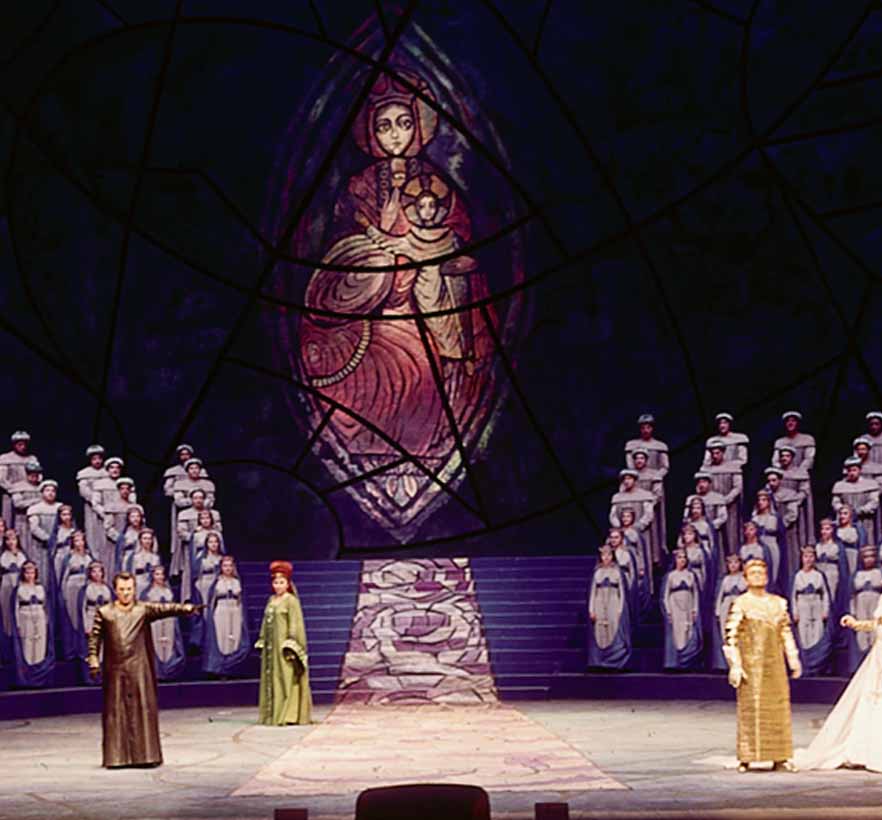Key Word Search
Multi-Field Search
Browse
Repertory Report
Performers Report
Contacts
Met Opera Website
New Production
Lohengrin
Metropolitan Opera House, Thu, December 8, 1966
Debut : Wieland Wagner, Peter Lehmann
Lohengrin (526)
Richard Wagner | Richard Wagner
- Lohengrin
- Sándor Kónya
- Elsa
- Ingrid Bjoner
- Ortrud
- Christa Ludwig
- Telramund
- Walter Berry
- King Heinrich
- John Macurdy
- Herald
- Sherrill Milnes
- Noble
- Dan Marek
- Noble
- Robert Schmorr
- Noble
- Gene Boucher
- Noble
- Ron Bottcher
- Conductor
- Karl Böhm
- Director
- Peter Lehmann [Debut] [Debut and only production]
- Production/Designer
- Wieland Wagner [Debut] [Debut and only production]
Wieland Wagner died on 10/16/66. Peter Lehmann took over the production, relying on Wagner's notes and similar stagings in Hamburg and Bayreuth.
Lohengrin received eighteen performances this season.
FUNDING:
Production a gift of Mrs. John D. Rockefeller, Jr.
Review 1:
Review in Time Magazine
Period Piece
In the past three months, Metropolitan Opera audiences have seen more exploding galleons, clashing armies and airborne tenors than they did in the thousand-and-one nights at the old house. Last week the Met staged its new production of "Lohengrin," and it, too, was a shocker - not for spectacle, but for lack of it. The stage was virtually stripped clean of scenery. Choristers stood in rigid rows like drill teams awaiting inspection; principal singers stirred hardly at all, and when they did, it was with the slow, deliberate movements of dream figures. The audience loved it, loudly bravoed Conductor Karl Böhm and Mezzo-Soprano Christa Ludwig. But the real star of the evening was not there: Richard Wagner's grandson Wieland.
Lohengrin was intended to be the vehicle for Wieland Wagner's long-awaited U.S. debut, but when he died three months ago at 49, his production was entrusted to his assistant. Peter Lehmann. Still, symbolically, Wieland was there. And fittingly so, for symbolism was his stock in trade. Lohengrin was garbed in heroic gold, Elsa in innocent white, Telramund in malevolent black. Ortrud in sinister green. In the background were painted stylized designs of a madonna, a dove and a swan. The swan, unfortunately, looked more like a Boeing 707, but, said Lehmann, "I wouldn't dare change it, because that's the way Wieland drew it."
Though Wieland's treatment may not have pleased everyone, there was no disputing that his influence will be felt in future Met productions; he buried once and for all the heavy-handed theatrics that characterized traditional Wagnerian productions. "All Wagner literature written before 1950 should be burned," he once said, "together with the old Wagnerians. For living theater, there can only be one style - that of its own period."
Thus, as Wieland interpreted the Ring cycle, Valhalla would be Wall Street, the heroes Siegfried and Siegmund self-sacrificing astronauts, the temptress Gutrune a mythological call girl, the god Wotan a wheeler-dealer politician, his wife Fricka everybody's nagging mother-in-law, and the spear-carrying Valkyries teen-age Beatle fans. Richard Wagner would have adored it, insisted Wieland. After all, no one despised the old Wagnerite purists more than Grandfather, who delighted in shocking admiring visitors by greeting them at the door on all fours and yapping like a fox terrier.
Photograph of a scene from Lohengrin by Louis Mélançon.
Search by season: 1966-67
Search by title: Lohengrin,
Met careers
- Karl Böhm [Conductor]
- Sándor Kónya [Lohengrin]
- Ingrid Bjoner [Elsa]
- Christa Ludwig [Ortrud]
- Walter Berry [Telramund]
- John Macurdy [King Heinrich]
- Sherrill Milnes [Herald]
- Dan Marek [Noble]
- Robert Schmorr [Noble]
- Gene Boucher [Noble]
- Ron Bottcher [Noble]
- Wieland Wagner [Production/Designer]
- Peter Lehmann [Director]
